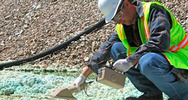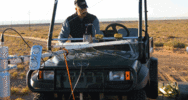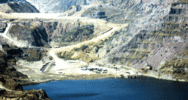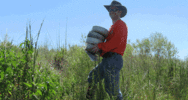Project Management Background
Foxfire Scientific has project management experience with a variety of radiological health and safety program operations. For a uranium mine closure project, we designed and implemented the worker safety program and monitoring protocols. We collaborated with the prime contractor from the initial proposal through to project completion. The safety program included air monitoring, contamination control, worker safety training, and bioassay monitoring. We prepared the safety aspects of the operating procedures and all the safety program procedures. In addition, Foxfire Scientific maintained all dosimetry records and provided closeout surveys and reports thereof.
In the area of retrospective studies, Foxfire Scientific has a proven track record as both the sole contractor and as a member of a team of specialists. Foxfire was selected to perform a dose reconstruction for workers and members of the public at and near a collection of uranium mines and mills, and along haul routes from the mines to the mills. We evaluated operations at the mines, ore haul routes with consideration of temporal variation in the tonnage transported, operation of the mills, atmospheric transport of released particulates, time and motion studies of potentially exposed individuals, and performed detailed analyses of the external and internal doses to the individuals.
In another instance, Foxfire was a member of a team wherein other firms performed the atmospheric and hydrologic transport analyses of radioactive contaminants and Foxfire subsequently performed the environmental transport through foodstuffs and the dose reconstruction to individuals. Foxfire Scientific also has experience with the management and oversight of the radiological characterization of CERCLA sites and similar sites, including FUSRAP sites. We have worked for both Potentially Responsible Parties and for owners of adjacent, impacted properties and government agencies. Foxfire has prepared the radiological component of conceptual site models, remedial investigation/feasibility studies, radiological characterization surveying and sampling plans, and human/ecological risk assessments. We have worked with other specialists such as geophysicists to perform site investigations to locate buried wastes and to prepare site management and remediation plans.
Surface Radon Flux Sampling Over Phosphogypsum Piles
Foxfire Scientific, Inc. was retained for its capability to perform radon emanation measurements at a gypsum stack in Pasadena, TX. The site has been classified as an inactive stack since 1981. Over 300 large area activated charcoal canister (LAACC) units were used to measure radon emanation rates across the stack to obtain radon flux data needed to demonstrate that the inactive gypsum stack emanations were still below NESHAP 40CFR61 Subpart R criteria.
The results of surface radon flux-measurements conducted by Foxfire Scientific allowed the stack to remain classified as inactive, which allowed the stack to be reclassified as beneficial material for use as tank base, road base, etc., as part of a future fuel tank farm (industrial land use with appropriate institutional controls).
Closure & Reclamation of a South Texas Uranium Mine

Foxfire Scientific, Inc. provided radiation safety project management during the reclamation activities conducted at the Mabel-New Superior uranium strip-mine located near Whitsett, Texas. This former mine had not been in operation since 1978 and was part of a commercial deer-hunting ranch. Due to erosion, the ore body had been located in near-surface deposits and strip mining had left several irregularly-shaped pits with remnant ore material and mine tailings deposited in mounds across 22 acres of the ranch. Heavy equipment was used to backfill the pits with the mound material and to grade the property. Employees working at this site were exposed to both external and internal sources of radiation due to the uranium ore present in the soil being excavated and moved.
Services provided included:
- Dosimetry program
- Bioassay program
- Personnel air sampling
- Radiation safety training
- Contamination monitoring
- Area gamma surveys
In addition to the above services, Foxfire Scientific also acted as liaison between the Texas Department of State Health Services, the Texas Railroad Commission and Apollo Environmental.
Copper Mine & Mill CERCLA Remediation

The former Anaconda copper mine near Yerington, NV, has gone through a series of owners; both traditional, open pit mining and heap leach extraction were conducted at the site. Historical operations resulted in contamination of ground water, as well as surface soils. Although the majority of contamination is related to heavy metals, potential issues with radioactive materials, especially uranium and radium, have been identified.
Foxfire Scientific, Inc. was originally retained on behalf of the Nevada Department of Environmental Protection (NDEP) to assist with worker radiological safety for NDEP contractor personnel performing caretaker functions at the site. When the US EPA assumed regulatory authority for the site under CERCLA, Foxfire Scientific transitioned to supporting BP, one of the potentially responsible parties, in efforts to conduct ongoing site maintenance, remedial investigation/feasibility study activities, and on- and off-site risk assessments.
Foxfire Scientific provides all the radiological risk assessment and characterization expertise for BP and their contractors. Activities include development and maintenance of the site Health and Safety Plan as related to radiological risks, preparation of operable unit-work plans with respect to radiological sampling, analysis, and assessment, conduct of field sampling, surveying activities, and oversight of EPA and EPA-contractor site activities.
Uranium Mill Disposal Site Characterization

Uranium Mill Disposal Site Characterization, El Paso Natural Gas, Navajo Nation Reservation near Tuba City, AZ
An old waste burial site across the highway from a former uranium mill was believed to contain waste from the mill. Mill structures and tailings were remediated under UMTRA in the late 1980’s. However, this waste burial site was not included in the remediation. Evidence that the waste came from the mill was a necessary next step in the clean up of radioactive debris at the site.
Foxfire Scientific performed gamma radiation surveys on tightly-spaced transects to identify areas with elevated radiation levels. Additional magnetic and electromagnetic surveys were performed by a geophysics-services teaming partner . The combined surveys identified multiple waste burial trenches, including locations where the burial cap had eroded or was nearly completely eroded. Confirmatory sampling was conducted to characterize the radioactive material. During the course of sampling, waste specifically traceable to the mill, in the form of ball mill-ceramic balls, was discovered.
The team’s efforts contributed to the US Congress setting aside $5M to remediate the site.
Assessment of Legacy Copper Mining Activities

A radiological environmental assessment was performed as part of a larger environmental assessment of a copper mining and milling concession near the city of Kolwezi in the Democratic Republic of Congo. The environmental assessment was performed in support of a World Bank financing request and to characterize the concession, which comprises several different open pit mines, underground mines, and at least three processing facilities, with respect to legacy environmental damage. Decades of prior activity by multiple owners had resulted in large disturbed areas. Complicating matters was that areas within the site had also been used as an ore storage pad for uranium ore from another location.
Extensive gamma radiation surveys were performed on the concession property and surrounding areas to determine the nature and extent of any environmental contamination. Composite soil sampling in the same locations as the surveys, and biased sampling in suspect areas with elevated survey results were collected. Water samples from surface water bodies used by co-located populations were collected. Sampling data was used to conduct a scoping-level risk assessment of present and proposed site conditions. A final report of the findings was prepared in accordance with World Bank and International Finance Corporation standards and requirements.
The project was completed under the original budget and ahead of schedule in support of revised project deadlines.










